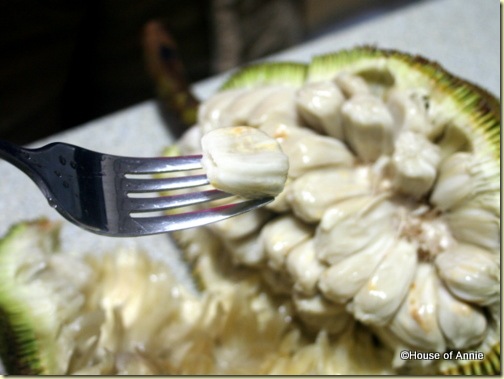It smells like a burning tire but tastes like the sweetest custard apple.

We are really happy to be living here in Sarawak. Time and again, the kindness and the generosity of the people here simply blow us away. Last month, when we invited our friend Paul and his family over for a big, home-cooked Japanese meal of miso soup, niku-jaga, kabocha no nimono, and sesame salad with chicken, they brought over a couple of these unique fruits called “buah tarap” to eat for dessert.
Borneo Native
Buah tarap (also called Marang) is a fruit that is native to Borneo. They are related to breadfruit and jackfruit. I have seen it in season in December, around the same time as the durian season. The fruits are about the same size and shape as a durian. However, the spines of the tarap are soft and rubbery compared to the hard, thorny spines of the durian.
The fruit does not fall when it ripens – usually they are harvested green and allowed to ripen off the tree. As they ripen, the outer rind turns from green to brownish-yellow. It also gives off a distinctive odor, that I liken to the smell of burning tires. Maybe that’s why buah tarap’s scientific name is Artocarpus odoratissimus!
Contrary to the difficulties in opening fruits like durian or jackfruit, the buah tarap is very easy to open. As the above picture shows, you simply pry apart the rind, which cleanly separates from the inner fruit. The fruit arils are all nestled inside, attached loosely to the stem.
These arils are similar in shape to a jackfruit, but they are not sticky nor slippery. The flesh is a creamy white. You could pick them off the stem – they come off with a slight twist/tug – or you can use a fork to gently lift them off. Once you have one, just pop it in your mouth!
The fruit itself is soft and creamy. It tastes like the sweetest custard apple or soursop, but it is smooth, not grainy. And just a bare hint of tartness. The flesh is easily separated from the small seed with your teeth. The seeds (or biji) themselves are edible. You just wash them, dry them overnight, then roast them in the oven. They taste like roasted nuts!
The fruits are so yummy and so easy to eat, one person could devour it alone in no time. After our party finished off one buah tarap for dessert, Paul left us with one more green fruit to enjoy in the following days. And he had also brought a big bag of buah tampoi that we all also enjoyed. See? Talk about generosity!

The only downside was having to endure the burning tire smell in the house for a few days while the fruit ripened. But we got over it. 😉
Aloha, Nate
I am entering this post into the 217th edition of Weekend Herb Blogging, hosted by Anna’s Cool Finds, and administered by Haalo.



I am not sure have you come across “cempedak” yet, it looks similar to tarap but the fruit is yellow/orange in colour.
I bought one tarap in Sabah, and didn’t get to try it as I left it there for too long.
Thanks for all this wonderful information, now I know what it is a called! I tasted this fruit in Sabah and have been looking for it in Johor where we live. Can’t understand why it is not growing here? We are going to Sarawak during Chinese New Year, hope we are lucky to find some at a road stall. Since it could be out of season for the fruit, I’ll plan my next trip better! Also loved the red skin bananas in Sarawak!
Any place in jb can buy buah tarap
There is a tree growing in Kota Tinggi which fruits and if you ask the owner, he will kindly allow you to pick a fruit.
I have seedlings available.
can you contact me,i want the seedlings,thanks
Hi, I’m hoping to find this fruit … do you know how I can find this owner?
Can I find Tarap in KL or Singapore?